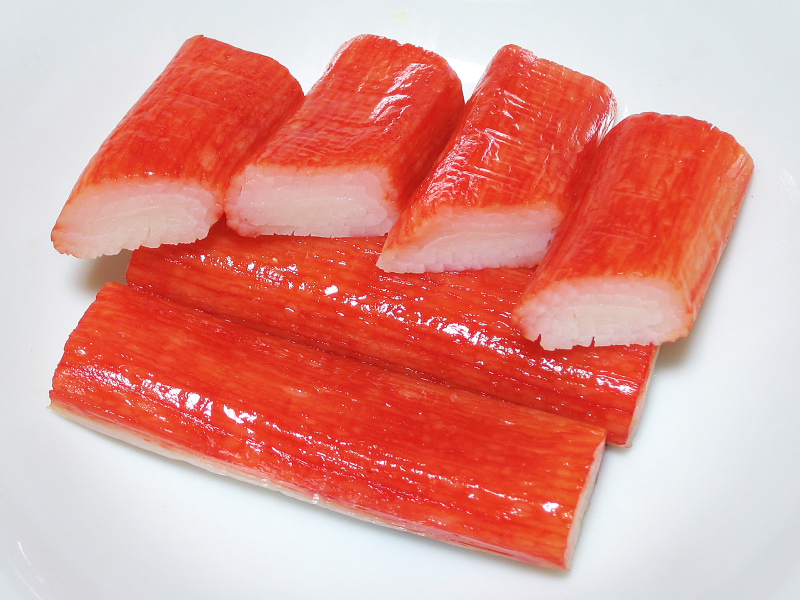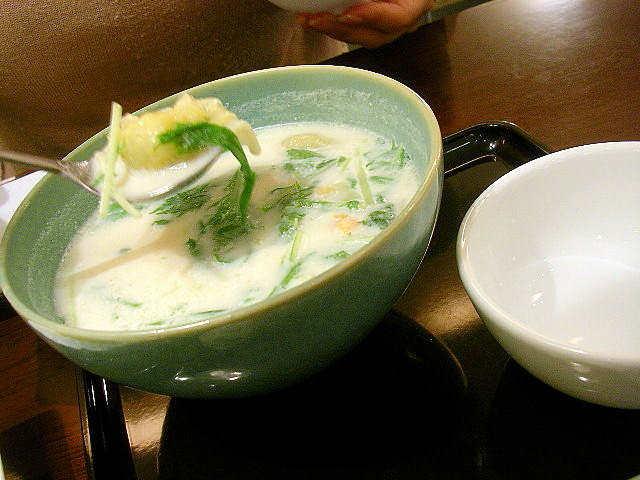|
A-gei
''Ageh'' () or ''Tamsui ageh'' () is a speciality food originating from Tamsui District of New Taipei City and consists of a piece of fried tofu, stuffed with cooked Cellophane noodles, and sealed with surimi, which is widely sold by vendors in the district. The name ageh was derived from ''aburaage'' (, ), a fried and stewed Japanese tofu packet from which the ageh is made. Culture The ageh was reportedly created in 1965 by Iông-tēⁿ Gím-bûn (楊鄭錦文), who combined various food items sold at her Chin-lí street (真理街) food stall to sell as a new food item. This original ageh consisted of fried tofu that has been emptied of its center, stuffed with cellophane noodles cooked in stewed ground pork, its opening sealed and covered with a carrot and surimi mixture, and then steamed to completion. The dish incorporates several techniques from other dishes, including the stuffing of abura-age in the manner of '' inarizushi'', the capping of tofu with surimi to make Yong ... [...More Info...] [...Related Items...] OR: [Wikipedia] [Google] [Baidu] |
Tofu
Tofu (), also known as bean curd in English, is a food prepared by coagulating soy milk and then pressing the resulting curds into solid white blocks of varying softness; it can be ''silken'', ''soft'', ''firm'', ''extra firm'' or ''super firm''. Beyond these broad textural categories, there are many varieties of tofu. It has a subtle flavor, so it can be used in savory and sweet dishes. It is often seasoned or marinated to suit the dish and its flavors, and due to its spongy texture, it absorbs flavors well. It is a traditional component of East Asian and Southeast Asian cuisines, and has been consumed in China for over 2,000 years. In modern western cooking, it is most often treated as a meat substitute. Nutritionally, tofu is low in calories, while containing a relatively large amount of protein. It is high in iron, and can have a high calcium or magnesium content depending on the coagulants (e.g. calcium chloride, calcium sulphate, magnesium sulphate) used in manufacturi ... [...More Info...] [...Related Items...] OR: [Wikipedia] [Google] [Baidu] |
List Of Stuffed Dishes
This is a list of stuffed dishes, comprising dishes and foods that are prepared with various fillings and stuffings. Some dishes are not actually stuffed; the added ingredients are simply spread atop the base food, as one cannot truly stuff an oyster or a mussel or a pizza. Stuffed dishes * A-gei * Apam balik * Arancini * Arem-arem * Badrijani * Bakpia Pathok * Ballotine * Bánh bao * Bánh chưng * Bánh lá * Bánh tét * Bánh xèo * Barbajuan * Bhendi fry * Bichak * Blini * Bolani * Boliche * Börek * Botillo * Cachopo * Carimañola * Carpetbag steak * Chả giò * Chatti pathiri * Chaudin – a meat dish from southern Louisiana, it is a sausage-like variant made from ingredients such as spices, pork, rice and vegetables that are sewn up in a pig's stomach, which is then cooked. The dish is sometimes smoked. * Chebureki * Chicken Kiev * Chile relleno * Chiles en nogada * Cordon bleu * Crappit heid – a traditional Scots fish course, consisting of a boil ... [...More Info...] [...Related Items...] OR: [Wikipedia] [Google] [Baidu] |
Surimi
is a paste made from Fish as food, fish or other meat. The term can also refer to a number of East Asian cuisine, East Asian foods that use that paste as their primary ingredient. It is available in many shapes, forms, and textures, and is often used to mimic the texture and color of the meat of lobster, crab, grilled Japanese eel or shellfish. The most common surimi product in the Western market is Crab stick, imitation crab meat. Such a product often is sold as ''krab,'' ''imitation crab'' and ''mock crab'' in the United States, and as ''seafood sticks'', ''crab sticks'', ''fish sticks'', ''seafood highlighter'' or ''seafood extender'' in Commonwealth of Nations, Commonwealth nations. In Britain, the product is sometimes known as ''seafood sticks'' to avoid breaking Trading Standards rules on false advertising. History Fish pastes have been a popular food in East Asia. In China, the food is used to make fish balls (魚蛋/魚丸) and ingredients in a thick soup known as "Geng ... [...More Info...] [...Related Items...] OR: [Wikipedia] [Google] [Baidu] |
Iron Egg
Iron egg () is a special version of soy egg, a snack from Taiwan. They are considered a delicacy and originated in the Tamsui District of New Taipei City. The dish consists of small eggs that have been repeatedly stewed in a mix of spices and air-dried. The resulting eggs are dark brown on the outside, chewy in texture, and very flavourful compared to standard boiled eggs. It has been said to taste "sweet, spicy and slightly salty with a concentrated egg flavour—a great snack with drinks". Iron eggs were popularized by shopkeeper Yang Bi-yun (楊碧雲), who opened the first store selling the product in Tamsui in 1980. She claimed her eggs were invented by accident when, on a slow day at her snack stall, she had to continually recook soy eggs (滷蛋) to keep them warm after taking them out of the soy sauce broth. The recooking and drying process eventually resulted in shrunken eggs that were dark, flavourful, and chewy, which were extremely popular with the locals. Yang event ... [...More Info...] [...Related Items...] OR: [Wikipedia] [Google] [Baidu] |
Taiwanese Cuisine
Taiwanese cuisine (, Bopomofo:ㄊㄞˊㄨㄢˉㄌㄧㄠˋㄌㄧˇ, or , Bopomofo:ㄊㄞˊㄨㄢˉㄘㄞˋ) has several variations. The earliest known cuisines of Taiwan are that of the Taiwanese indigenous peoples. Over hundred years of historical development; mainstream Taiwanese cuisine has been influenced by Hakka cuisine, the cuisines of the '' waishengren,'' and Japanese cuisine. Although southern Fujian cuisine has had the most profound impact. History and development Taiwanese culinary history is murky and is intricately tied to patterns of migration and colonization. Local and international Taiwanese cuisine, including its history, is a politically contentious topic. Taiwan's complex and diverse identity makes Taiwanese cuisine hard to communicate. The history of Taiwanese cuisine began with the cuisine of aboriginal peoples on the island of Taiwan, which existed in the ancient times without written records. From the Ming dynasty in 16th century, a large number of im ... [...More Info...] [...Related Items...] OR: [Wikipedia] [Google] [Baidu] |
Soy Milk
Soy milk (simplified Chinese: 豆浆; traditional Chinese: 豆漿) also known as soya milk or soymilk, is a plant-based drink produced by soaking and grinding soybeans, boiling the mixture, and filtering out remaining particulates. It is a stable emulsion of oil, water, and protein. Its original form is an intermediate product of the manufacture of tofu. Originating in China, it became a common beverage in Europe and North America in the latter half of the 20th century, especially as production techniques were developed to give it a taste and consistency more closely resembling that of dairy milk. Soy milk may be used as a substitute for dairy milk by individuals who are vegan or are lactose intolerant. Soy milk is also used in making imitation dairy products such as soy yogurt, soy cream, soy kefir and soy-based cheese analogues. It is also used as an ingredient for making milkshakes, pancakes, smoothies, bread, mayonnaise, and baked goods. Names In China, the usual ter ... [...More Info...] [...Related Items...] OR: [Wikipedia] [Google] [Baidu] |
Culture In New Taipei
Culture () is an umbrella term which encompasses the social behavior, institutions, and norms found in human societies, as well as the knowledge, beliefs, arts, laws, customs, capabilities, and habits of the individuals in these groups.Tylor, Edward. (1871). Primitive Culture. Vol 1. New York: J.P. Putnam's Son Culture is often originated from or attributed to a specific region or location. Humans acquire culture through the learning processes of enculturation and socialization, which is shown by the diversity of cultures across societies. A cultural norm codifies acceptable conduct in society; it serves as a guideline for behavior, dress, language, and demeanor in a situation, which serves as a template for expectations in a social group. Accepting only a monoculture in a social group can bear risks, just as a single species can wither in the face of environmental change, for lack of functional responses to the change. Thus in military culture, valor is counted a typical be ... [...More Info...] [...Related Items...] OR: [Wikipedia] [Google] [Baidu] |
Tea Egg
Tea egg is a typical Chinese savory food commonly sold as a snack, in which a boiled egg is cracked slightly and then boiled again in tea, and sauce or spices. It is also known as marble egg because cracks in the egg shell create darkened lines with marble-like patterns. Commonly sold by street vendors or in night markets in most Chinese communities throughout the world, it is also served in Asian restaurants. Although it originated from China and is traditionally associated with Chinese cuisine, other similar recipes and variations have been developed throughout Asia. Tea eggs originated in Zhejiang province as a way to preserve foods for a long time but is now found in all provinces. Preparation Traditional method Fragrant and flavorful tea eggs are a traditional Chinese food. The original recipe uses various spices, soy sauce, and black tea leaves. A commonly used spice for flavoring tea eggs is Chinese five-spice powder, which contains ground cinnamon, star anise, ... [...More Info...] [...Related Items...] OR: [Wikipedia] [Google] [Baidu] |
Fish Ball
Fish balls are rounded meat balls made from fish paste which are then boiled or deep fried. Similar in composition to fishcake, fish balls are often made from fish mince or surimi, salt, and a culinary binder such as tapioca flour, corn, or potato starch. Fish balls are popular in East and Southeast Asia, where they are eaten as a snack or added to soups or hotpot dishes. They are usually attributed to Chinese cuisine and the fish ball industry is largely operated by people of Chinese descent. European versions tend to be less processed, sometimes using milk or potatoes for binding. Nordic countries also have their own variation. Production There are two variants of fish balls, each differing in its textures, production method, and primary regions of production: Asia While the ingredients and methods are similar between countries, differences can be noted in terms of elasticity, colour, and flavour. Fish balls in Hong Kong and the Philippines can be more firm, darker, ... [...More Info...] [...Related Items...] OR: [Wikipedia] [Google] [Baidu] |
Tamsui District
Tamsui District (Hokkien POJ: ''Tām-chúi''; Hokkien Tâi-lô: ''Tām-tsuí''; Mandarin Pinyin: ''Dànshuǐ'') is a seaside district in New Taipei, Taiwan. It is named after the Tamsui River; the name means "fresh water". The town is popular as a site for viewing the sun setting into the Taiwan Strait. Though modest in size (population 184,192), it has a large role in Taiwanese culture. Name Historical Originally settled by the Ketagalan aborigines, the location was called ''Hoba'', meaning "stream's mouth". ''Hoba'' was loaned into Taiwanese Hokkien as ''Hobe''. Historical works in English have referred to the place as "Hobe", "Hobé", or "Hobe Village". The Spanish arrived in the 17th century and called this place ''Casidor'' and the Tamsui River ''Kimalon''. Dutch records have used the placenames ''Tamsuy'' and ''Tampsui'' to refer to this area but have also referred to another " Lower Tamsuy" in the south of the island. In his 1903 book ''The Island of Formosa'', form ... [...More Info...] [...Related Items...] OR: [Wikipedia] [Google] [Baidu] |








